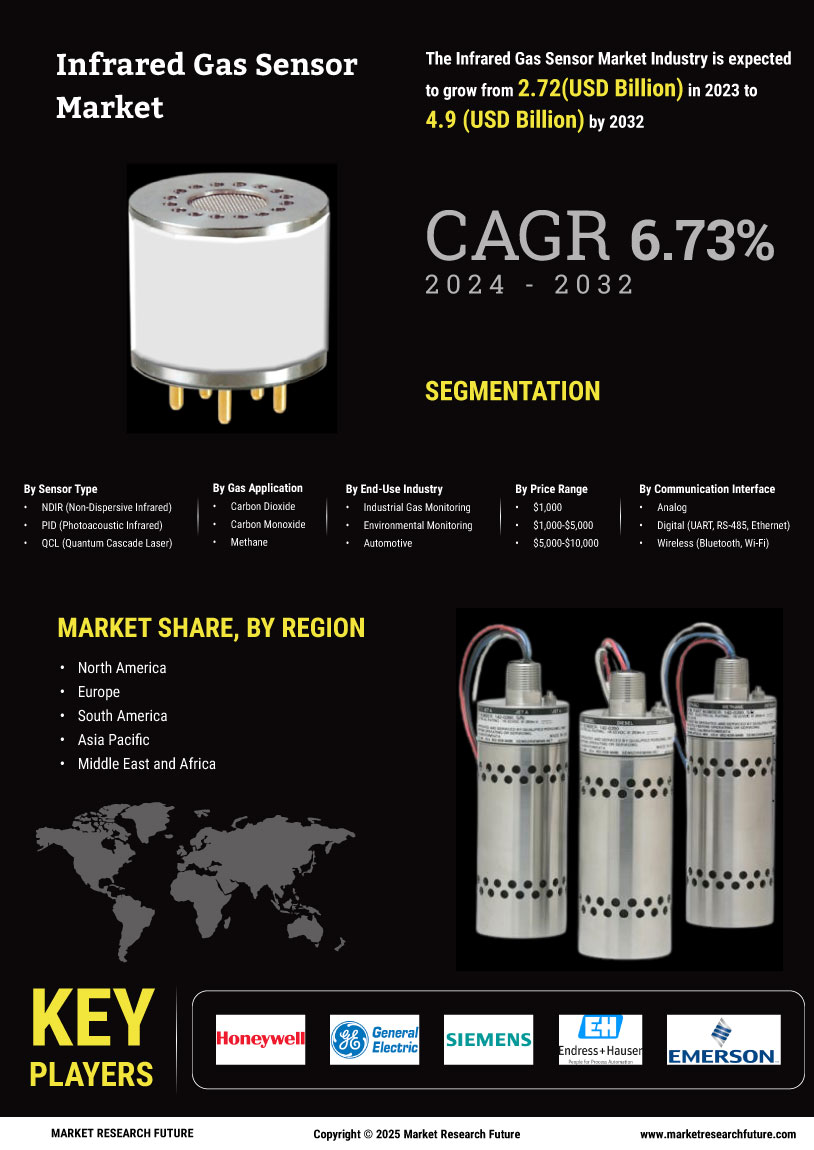Increased Regulatory Compliance
The Infrared Gas Sensor Market is significantly influenced by the rise in regulatory compliance across various sectors. Governments and regulatory bodies are implementing stringent guidelines to monitor and control emissions, particularly in industries such as oil and gas, manufacturing, and waste management. This regulatory landscape necessitates the use of advanced gas detection technologies, including infrared sensors, to ensure compliance with safety and environmental standards. For instance, regulations regarding volatile organic compounds (VOCs) and greenhouse gas emissions are driving the adoption of infrared gas sensors. The market is expected to benefit from this trend, as companies invest in reliable monitoring solutions to avoid penalties and enhance operational safety. As compliance requirements become more rigorous, the Infrared Gas Sensor Market is poised for growth, with an increasing number of industries recognizing the importance of effective gas detection.
Focus on Environmental Sustainability
The Infrared Gas Sensor Market is increasingly aligned with the global focus on environmental sustainability. As concerns about air quality and climate change intensify, there is a growing demand for technologies that can accurately monitor and reduce emissions. Infrared gas sensors play a crucial role in this context, enabling real-time monitoring of harmful gases and pollutants. Industries are adopting these sensors to not only comply with regulations but also to demonstrate their commitment to sustainability. The market is projected to expand as more organizations recognize the value of integrating infrared gas sensors into their environmental management systems. This trend is further supported by initiatives aimed at reducing carbon footprints and promoting cleaner technologies. Consequently, the Infrared Gas Sensor Market is likely to see increased investment and innovation as stakeholders prioritize sustainable practices.
Rising Demand in Industrial Applications
The Infrared Gas Sensor Market is witnessing a notable rise in demand within industrial applications. Industries such as petrochemicals, pharmaceuticals, and food processing are increasingly utilizing infrared gas sensors for safety and quality control purposes. These sensors are essential for detecting hazardous gases, ensuring worker safety, and maintaining compliance with health regulations. The market is expected to grow as industries recognize the importance of reliable gas detection systems in preventing accidents and ensuring operational efficiency. Furthermore, the integration of infrared sensors into automated systems enhances monitoring capabilities, allowing for real-time data analysis and response. As industries continue to prioritize safety and efficiency, the Infrared Gas Sensor Market is likely to experience sustained growth driven by the increasing adoption of these technologies.
Emerging Applications in Smart Technologies
The Infrared Gas Sensor Market is expanding due to emerging applications in smart technologies. The integration of infrared gas sensors into smart home systems, smart cities, and industrial IoT applications is creating new opportunities for growth. These sensors enable real-time monitoring of air quality and gas emissions, contributing to enhanced safety and environmental awareness. As consumers and businesses increasingly adopt smart technologies, the demand for reliable gas detection solutions is expected to rise. The market is projected to benefit from innovations that allow for seamless connectivity and data sharing between sensors and other smart devices. This trend indicates a shift towards more intelligent and responsive systems, positioning the Infrared Gas Sensor Market for significant advancements in the coming years.
Technological Advancements in Infrared Gas Sensors
The Infrared Gas Sensor Market is experiencing rapid technological advancements that enhance sensor performance and reliability. Innovations such as improved optical components and advanced signal processing algorithms are being integrated into new sensor designs. These advancements not only increase sensitivity and selectivity but also reduce response times, making sensors more effective in detecting various gases. The market is projected to grow at a compound annual growth rate of approximately 7% over the next five years, driven by these technological improvements. Furthermore, the development of miniaturized sensors allows for easier integration into portable devices, expanding their application in various sectors, including industrial safety and environmental monitoring. As technology continues to evolve, the Infrared Gas Sensor Market is likely to witness a surge in demand for more sophisticated and efficient gas detection solutions.

















Leave a Comment